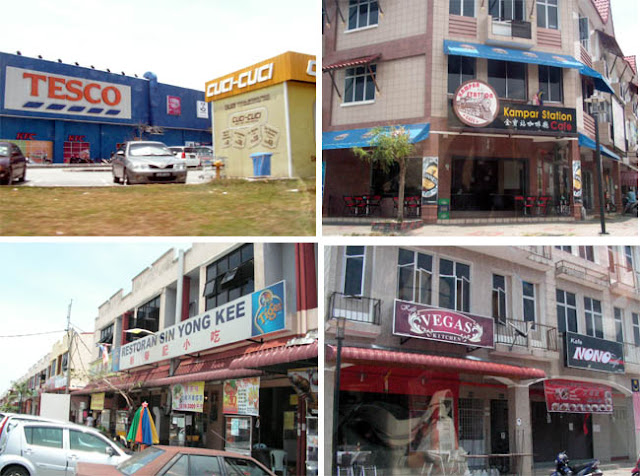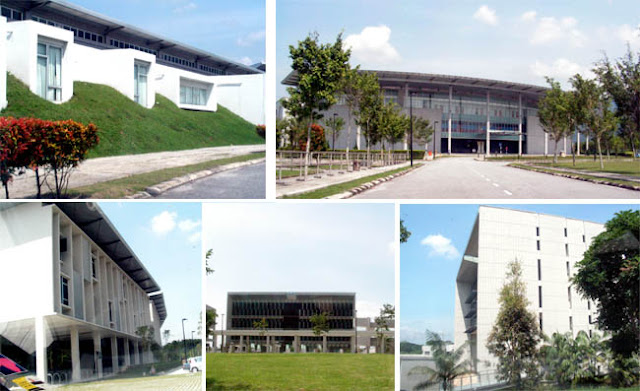Johor Bahru, is the southernmost city on
Eurasian mainland, the second largest city in Malaysia, and the sole doorway to reach Singapore by road. The city was established by Temeggong Ibrahim in 1855, while Wong Ah Fook, a Chinese contractor had great contribution over the early development of the city.
While standing beside Tebrau Strait, overlooking Woodland on the other side of the strait, our mindset about the city changed. Most of the news about the city that reached us before our trip, were on the darker site. As we roamed around, we found that the city was clean, organized, well landscaped with shrubs and plaza on the southern part, where most of the tourists like us whirl around. The northern part with residential areas was less organized. We stayed for three days two nights.

Flanking Tebrau Strait, we took our way to Danga Bay through Sawmill Road to Skudai Road (upper left), old shoplots along Wong Ah Fook Road (upper middle), nicely tiled and palms embellished alley (upper right). Hawkers around JB city center (lower left), plenty of chairs for sour feet (lower middle), and the greenery bordering Wong Ah Fook Road.
Sawmill Road is a nice location to take a view on the other site of Tebrau Strait- Woodland. The causeway on our left connected the people from two countries. An unofficial resource estimated that the causeway serves more than one hundred thousand commuters from both sides daily. The location where this photo was taken is just around 600 meters away from City Square.
From Kajang Selangor, we took almost 4 hours to reach JB by car. As we travelled from north, Metropolis Towers is a prominent landmark for us (left). There was no sense of hustle-bustle on the streets nearby to our hotel, on the eve of Hari Raya Aidilfitri (upper right). New York Hotel, 25 floors, is another landmark in JB.
A nice view of the heart of JB from our room's window. Woodland can be seen from afar, backgrounding the sky scrapers with lower density of population and lusher environment.
We stayed in
New York Hotel, around 3 km away from the heart of the city. The hotel was good overall, from amenities such as tv, hair dryer, coffee making facility, fridge, to room service, dining area, nicely decorated lobby with National Geographic on the LCD flatscreens, and polite English speaking staffs. Well, if we really want to put something on the negative side- the bathroom with rusty metal handle and the flush for the toilet was not powerful enough. The hotel is quite a distance away from city center. Anyway, the transportation might not be an issue as there is a taxi stand just beside the hotel.
The lobby and the receptionist counter (upper left), area beside the front door (upper middle), and the staircase to first and second floor (upper right) of New York Hotel. The hotel's room was clean with excellent air-condition.
Places of interest in JB in our list: Danga Bay, Abu Bakar Mosque, Johor Zoo, Sultan Abu Bakar Royal Museum, Johor Bahru Chinese Temple, Sultan Ibrahim Building and City Square (a shopping center). Well, all of them didn't score high in our rating, but still worth a "touch and go".
Danga Bay, around 8 km away from city center, might be a good place to spend a night- hawker center, restaurants, Marine Club (left and middle), circus, Danga Bay Cruise and amusement park, most of them start operation at night. Danga Bay was quiet when we visited the place, as the hawker center and food court was closed for the celebration of Hari Raya Aidilfitri.
Danga Bay at night.
Built in 1927, Immaculate Conception Church is one of the oldest Catholic Church in JB (left row). The church is located at Gereja Road, by foot, 10 minutes away from City Square. The middle row shows Johor Bahru Old Chinese Temple. Built at the end of 19th century by Chinese leaders, the temple has stood as a place to pray for peace and prosperity for more than 130 years. Located beside Trus Road, the temple looks odd in the middle of the most developed area. Abu Bakar Mosque shows strong influence of English Victorian Architecture. The mosque was build around 1900 by ruling Sultan Abu Bakar. The mosque is just opposite of Johore Zoo, around 2.5 km away from city center.

Located roughly 500 meters away from City Square, Sultan Ibrahim Building, built by Sultan Ibrahim in 1939, serves as Johor State Secretariat Building now (upper left).The building opens 8 am- 4:30 pm to public on normal working days. Beautiful landscape in front of Johor Royal Museum (upper right). Johor Royal Museum houses a collection of royal work of arts, souvenirs, medals, weapons, furniture etc. (lower row). The operational hours of the museum is 9 am- 5 pm. We couldn't enter the state secretariat building and museum due to public holiday..
JB Zoo is not big at all. But it still can promise a full one hour or two of sweat and fun. Opens on 9 am- 6 pm daily, the entry was just RM 2 per adult with a suprising large number of animals. The zoo is well-maintained therefore worth a visit. As it was opened on the second day of Hari Raya Aidilfitri, we guess that the zoo is operational throughout the public holidays.
An island with flamingos, swans, and other type of birds (upper left). Tapir, harimau and musang were some of the animals on display. To know their name in English, why don't you visit the zoo yourself? During the visit, a big pelican hijacked visitors attention (lower right).
A lake for water activities is available in the zoo.
Talk about shopping, JB might be a good place for Singaporean (due to the forex). But, believe us, the price is not friendly to Malaysian. We did visit Pelangi Mall and City Square. Both shopping complexes are small, compared to what we have in KL. Anyway, if you have the chance to visit JB, take a walk in City Square, as it is bigger and more attractive.
A view in City Square. The mall's management has thoughtfully prepared a phone booth for superman, in case of emergency :-p
A donut in JB? City Mall has JCo. A line of oversea franchises like McD, Stabuck, Coffee Bean, Kenny Roger, Sushi King etc. are available as well.
Food, ah! We tried mamak (Indian Muslim) food, Chinese food, seafood, and some western food. All of them tasted like ...... Malaysian food (ouch!). If you have never ever tried Malaysian food before, the hawkers on the streets and food courts will serve you well. If you know Malaysian food well, especially if you are a Malaysian, we personally do not have any name in our recommendation list for you (please share with us if you have some in your list).
Chinese food for supper.
The mamak stall beside our hotel (upper left) and a food court at Tebrau Garden, about 1 km away from our hotel with many food stalls (upper right). Both of the places mentioned here cannot be reached by foot from city center. Lower row from left to right: seafood, BBQ fish, "lok-lok", and fried "kuey-tiaw". "Lok-lok" contains the mixture of boiled dumpling, vege, meat, fishball etc. "Kuey-tiaw" is a kind of local flat noodle.
If you have the chance to visit JB, our recommendation is, take some time to walk around. You might find hidden gem around this coastal city, such as the zoo. Most of the tourist attractions are on the southern part of the city, so get a hotel nearby the city center might be a good idea. If you can rent a car, then you can aim for the hotels further away. Road system in JB is quite simple for us, and we had no problem to find our way through the city.
You can visit Danga Bay, Johor Zoo, Abu Bakar Mosque, and royal museum in a roll, as all of them are located beside a same stretch of road with different name- from Sawmill Road to Skudai Road (follow the sign of Skudai Road). Rent a car or join a local tour might be a good idea.
If you are on a tight schedule, a well-planned whole day trip may covers all the attractions in JB. Morning on working day- Sultan Ibrahim building, follow by Johor Royal Museum, Abu Bakar Mosque, and Johor Zoo with a snack in the zoo. Then, head back to city center for lunch at City Square before take a walk to visit Old Johor Bahru Chinese Temple and
Immaculate Conception Church. You can roam around city center, enjoy some nice food from the hawkers and lastly, take a transport to Danga Bay in the evening for a leisuring dinner. For more information about JB, you can visit Official site for
Johore Tourism Portal, Travellers' comments at
Tripadvisor, and
Johor Tourism page. You might like to follow our sharing about Johor Bahru at links below.

























